一、实验目的
- 能够运用 wireshark 对 OpenFlow 协议数据交互过程进行抓包;
- 能够借助包解析工具,分析与解释 OpenFlow协议的数据包交互过程与机制。
二、实验环境
- 下载虚拟机软件Oracle VisualBox;
- 在虚拟机中安装Ubuntu 20.04 Desktop amd64,并完整安装Mininet;
三、实验要求
(一)基本要求
- 搭建下图所示拓扑,完成相关 IP 配置,并实现主机与主机之间的 IP 通信。用抓包软件获取控制器与交换机之间的通信数据包。
![]()
| 主机 | IP地址 |
|---|---|
| h1 | 192.168.0.101/24 |
| h2 | 192.168.0.102/24 |
| h3 | 192.168.0.103/24 |
| h4 | 192.168.0.104/24 |
- 修改主机IP地址和 控制器IP:
![]()
![]()
-
保存拓扑文件
![]()
-
首先打开一个终端输入
sudo wireshark打开wires hark,选择any进行抓包,然后打开另一个终端打开保存的拓扑文件。
![]()
-
查看抓包结果,分析OpenFlow协议中交换机与控制器的消息交互过程
-
OFPT_HELLO控制器6633端口 ---> 交换机38216端口,从控制器到交换机
![]()
-
OFTP_HELLO 交换机38216端口---> 控制器6633端口
![]()
双方建立连接,并使用OPenflow 1.0 -
OFTP_FEATRUES_REQUEST控制器6633端口 ---> 交换机38216端口,从控制器到交换机。控制器请求交换器的特征信息
![]()
-
OFTP_SET_CONFIG控制器6633端口 ---> 交换机38216端口。控制器要求交换机按照所给出的信息进行配置
![]()
-
OFTP_PORT_STATUS当交换机端口发生变化时,告知控制器相应的端口状态。
![]()
-
OFTP_FEATURES_REPLY交换机38216端口---> 控制器6633端口。交换机告知控制器它的特征信息
![]()
-
OFTP_PACKET_IN交换机38216端口(有数据包进来,请指示)--- 控制器6633端口
![]()
-
OFTP_FLOW_MOD分析抓取的flow_mod数据包,控制器通过6633端口向交换机38216端口、交换机38216端下发流表项,指导数据的转发处理
![]()
-
OFTP_PACKET_OUT控制器6633端口 ---> 交换机38216端口
![]()
-
回答:交换机与控制器建立通信时是使用TCP协议还是UDP协议?
![]()
采用的是TCP协议 -
流程图
![]()
二、进阶要求
- 将抓包结果对照OpenFlow源码,了解OpenFlow主要消息类型对应的数据结构定义。相关数据结构可在openflow安装目录openflow/include/openflow当中的openflow.h头文件中查询到。
- HELLO
![]()
/* Header on all OpenFlow packets. */
struct ofp_header {
uint8_t version; /* OFP_VERSION. */
uint8_t type; /* One of the OFPT_ constants. */
uint16_t length; /* Length including this ofp_header. */
uint32_t xid; /* Transaction id associated with this packet.
Replies use the same id as was in the request
to facilitate pairing. */
};
- FEATURES_REQUEST
![]()
与HELLO的代码段一致
3. SET_CONFIG
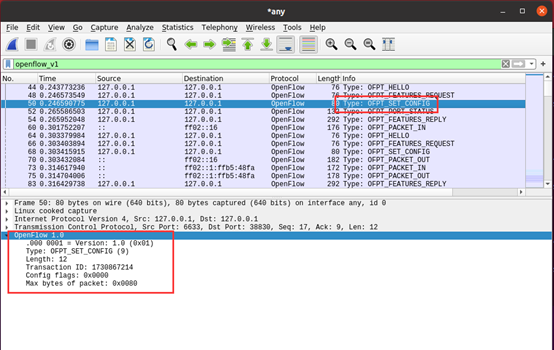
/* Switch configuration. */
struct ofp_switch_config {
struct ofp_header header;
uint16_t flags; /* OFPC_* flags. */
uint16_t miss_send_len; /* Max bytes of new flow that datapath should
send to the controller. */
};
- PORT_STATUS
![]()
/* A physical port has changed in the datapath */
struct ofp_port_status {
struct ofp_header header;
uint8_t reason; /* One of OFPPR_*. */
uint8_t pad[7]; /* Align to 64-bits. */
struct ofp_phy_port desc;
};
- FEATURES_REPLAY
![]()
/* Description of a physical port */
struct ofp_phy_port {
uint16_t port_no;
uint8_t hw_addr[OFP_ETH_ALEN];
char name[OFP_MAX_PORT_NAME_LEN]; /* Null-terminated */
uint32_t config; /* Bitmap of OFPPC_* flags. */
uint32_t state; /* Bitmap of OFPPS_* flags. */
/* Bitmaps of OFPPF_* that describe features. All bits zeroed if
* unsupported or unavailable. */
uint32_t curr; /* Current features. */
uint32_t advertised; /* Features being advertised by the port. */
uint32_t supported; /* Features supported by the port. */
uint32_t peer; /* Features advertised by peer. */
};
/* Switch features. */
struct ofp_switch_features {
struct ofp_header header;
uint64_t datapath_id; /* Datapath unique ID. The lower 48-bits are for
a MAC address, while the upper 16-bits are
implementer-defined. */
uint32_t n_buffers; /* Max packets buffered at once. */
uint8_t n_tables; /* Number of tables supported by datapath. */
uint8_t pad[3]; /* Align to 64-bits. */
/* Features. */
uint32_t capabilities; /* Bitmap of support "ofp_capabilities". */
uint32_t actions; /* Bitmap of supported "ofp_action_type"s. */
/* Port info.*/
struct ofp_phy_port ports[0]; /* Port definitions. The number of ports
is inferred from the length field in
the header. */
};
- PACKET_IN
![]()
/* Packet received on port (datapath -> controller). */
struct ofp_packet_in {
struct ofp_header header;
uint32_t buffer_id; /* ID assigned by datapath. */
uint16_t total_len; /* Full length of frame. */
uint16_t in_port; /* Port on which frame was received. */
uint8_t reason; /* Reason packet is being sent (one of OFPR_*) */
uint8_t pad;
uint8_t data[0]; /* Ethernet frame, halfway through 32-bit word,
so the IP header is 32-bit aligned. The
amount of data is inferred from the length
field in the header. Because of padding,
offsetof(struct ofp_packet_in, data) ==
sizeof(struct ofp_packet_in) - 2. */
};
- PACKET_OUT
![]()
/* Send packet (controller -> datapath). */
struct ofp_packet_out {
struct ofp_header header;
uint32_t buffer_id; /* ID assigned by datapath (-1 if none). */
uint16_t in_port; /* Packet's input port (OFPP_NONE if none). */
uint16_t actions_len; /* Size of action array in bytes. */
struct ofp_action_header actions[0]; /* Actions. */
/* uint8_t data[0]; */ /* Packet data. The length is inferred
from the length field in the header.
(Only meaningful if buffer_id == -1.) */
};
- FLOW_MOD
![]()
/* Flow setup and teardown (controller -> datapath). */
struct ofp_flow_mod {
struct ofp_header header;
struct ofp_match match; /* Fields to match */
uint64_t cookie; /* Opaque controller-issued identifier. */
/* Flow actions. */
uint16_t command; /* One of OFPFC_*. */
uint16_t idle_timeout; /* Idle time before discarding (seconds). */
uint16_t hard_timeout; /* Max time before discarding (seconds). */
uint16_t priority; /* Priority level of flow entry. */
uint32_t buffer_id; /* Buffered packet to apply to (or -1).
Not meaningful for OFPFC_DELETE*. */
uint16_t out_port; /* For OFPFC_DELETE* commands, require
matching entries to include this as an
output port. A value of OFPP_NONE
indicates no restriction. */
uint16_t flags; /* One of OFPFF_*. */
struct ofp_action_header actions[0]; /* The action length is inferred
from the length field in the
header. */
};
实验总结
- 遇到的问题:在实验过程遇到的问题是,在实验过程中没抓到OPEN_FLOW的包,连续试了几次都没有这个包,后来在网上查阅了相关的资料,在运行完成保存的拓扑文件之后还需要进行一次ping操作,这样wireshark 才能抓到openflow的包。
- 实验感想:这次实验难度适中,在整个过程中还算是比较流畅,但是我在实验的过程中连续抓了好几次包,实验过程截图并不是在一个包里面截图的,导致在实验报告里面出现了许多不同的端口号,实验报告是以我的第一包为准即端口号38216;我的实验是分两次做的,进阶要求部分吸取了第一次实验的教训,一次操作就完成了,截图也是在抓到的同一个包里面截图的即端口号38832;最后在openlow的源码里面找到相应部分的源码花费了较多的时间,整个实验做下来还算流畅。





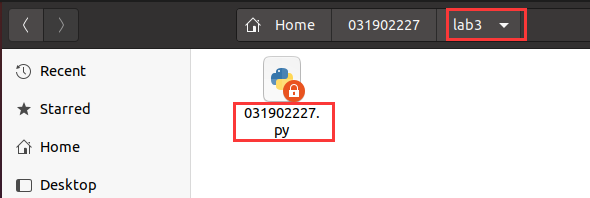
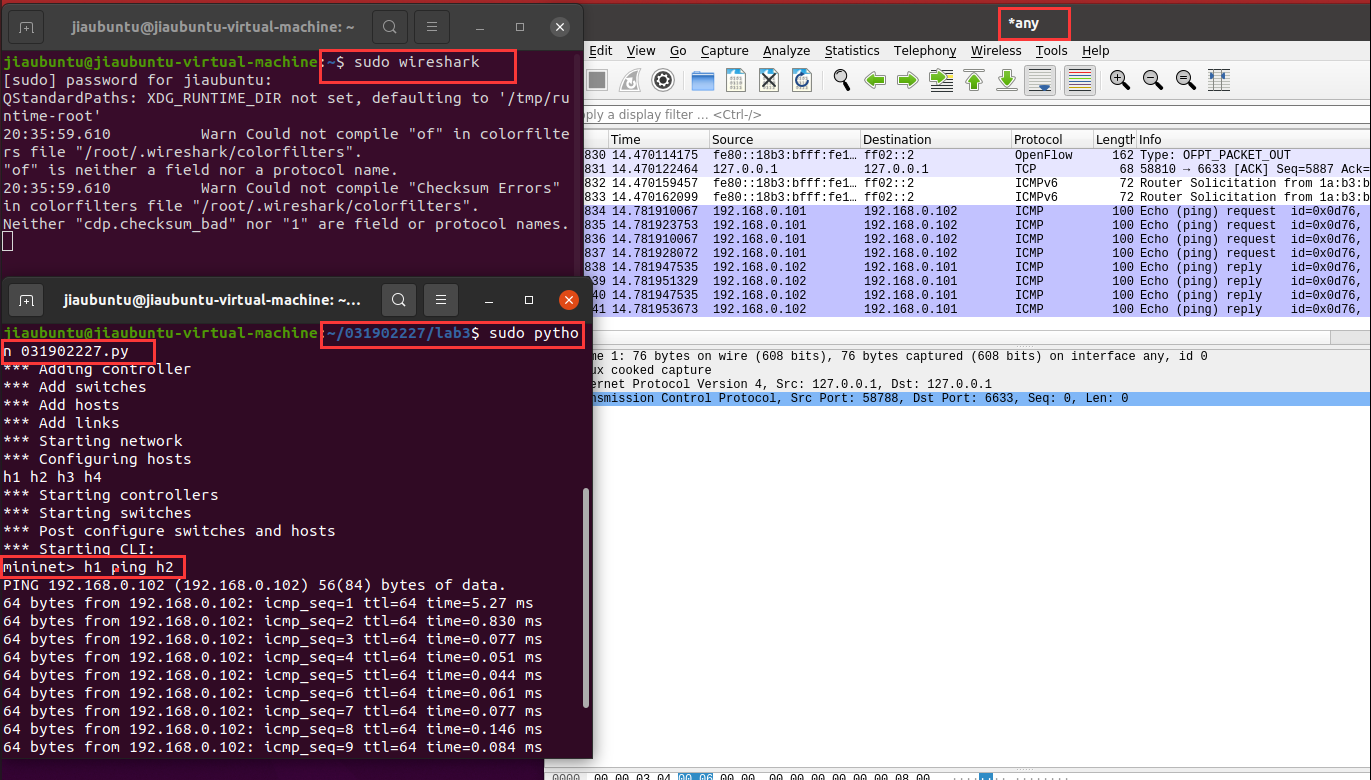
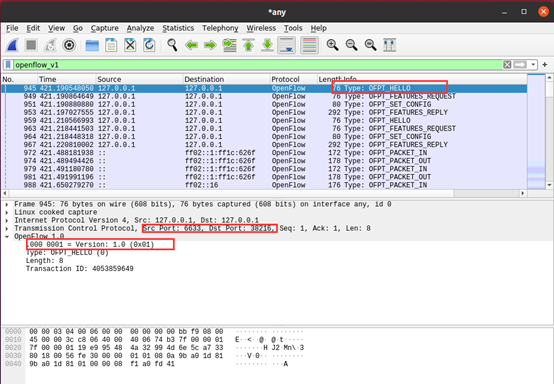
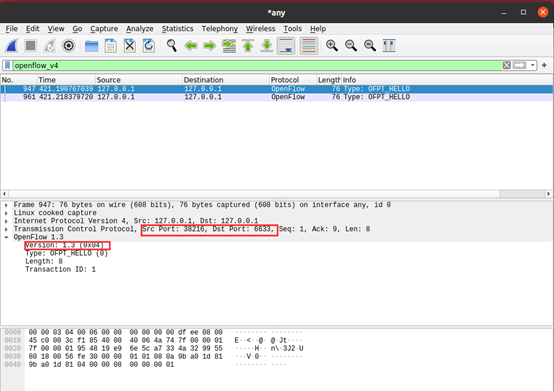
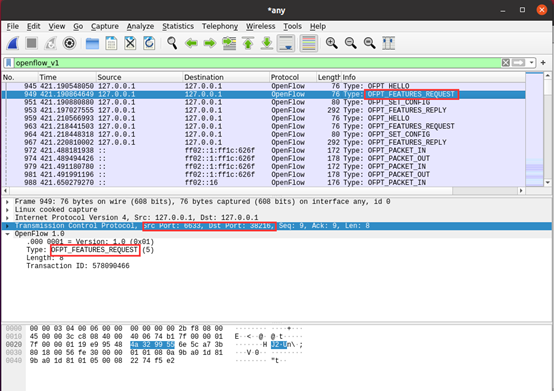
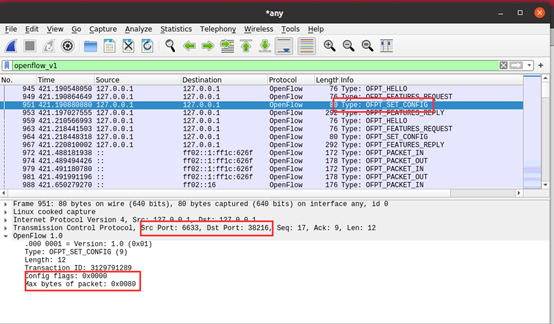
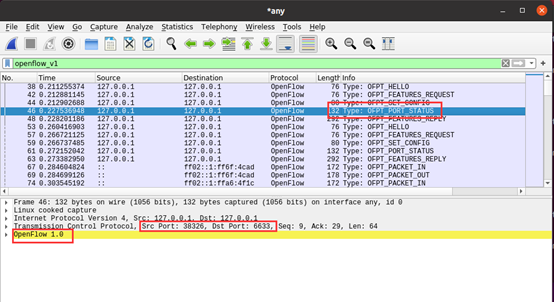
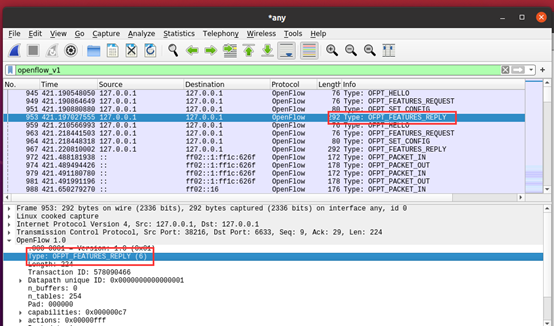
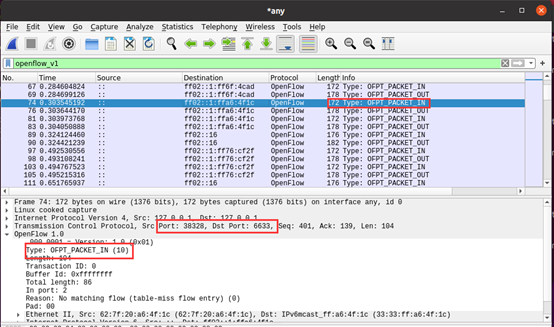

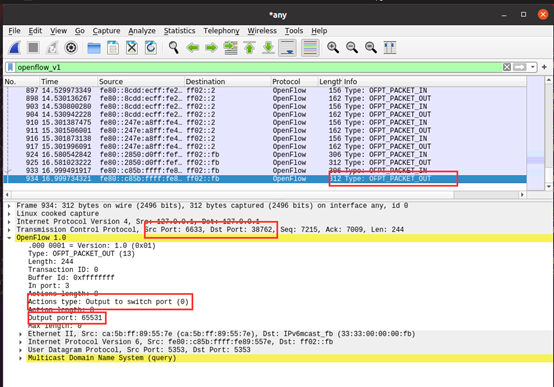
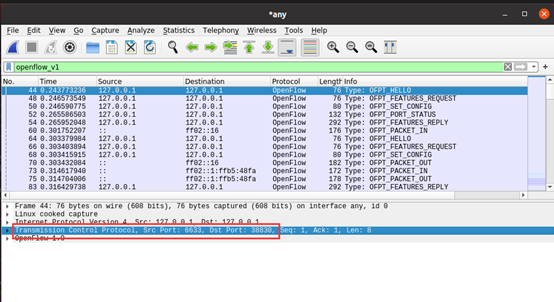

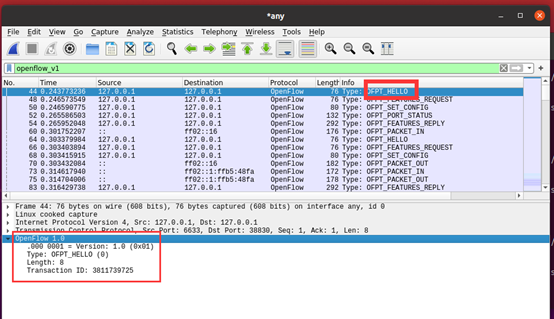
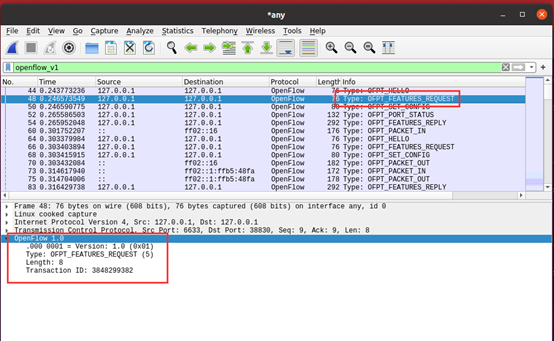

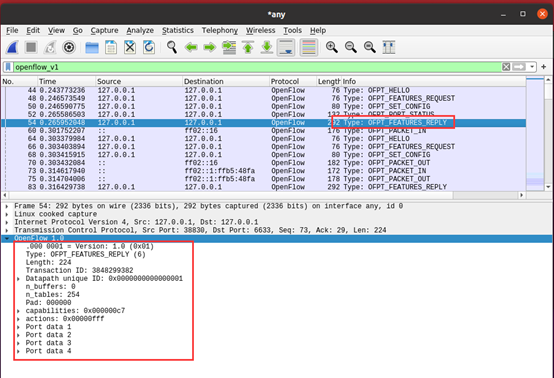

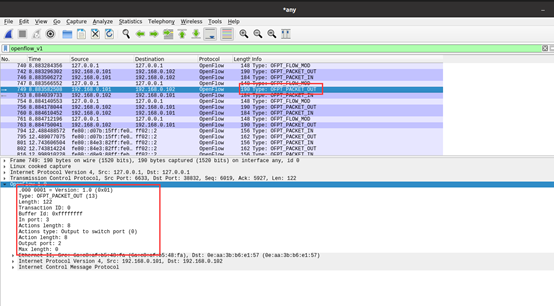


 浙公网安备 33010602011771号
浙公网安备 33010602011771号